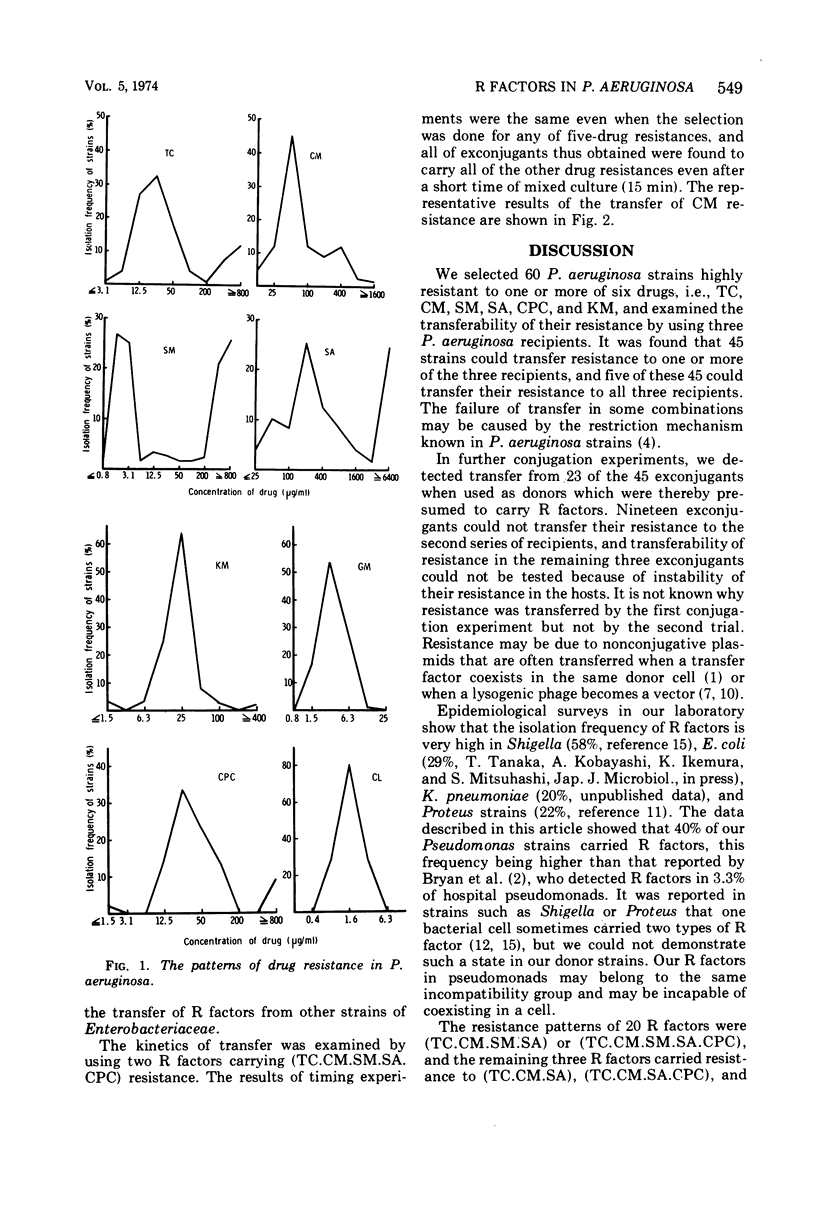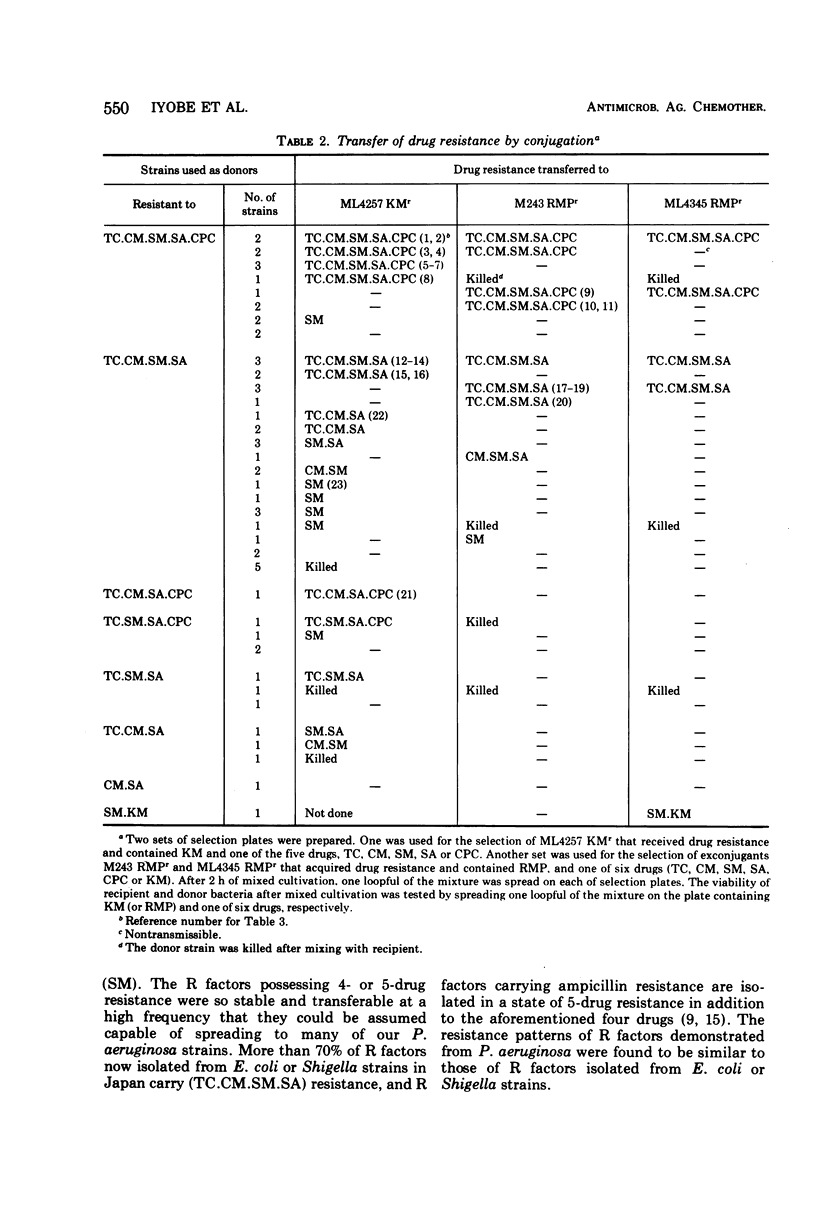Abstract
Sixty strains of Pseudomonas aeruginosa were selected from our clinical stock cultures and used as donors of drug resistance to examine the presence of R factors. They were highly resistant to one or more of six drugs including tetracycline (TC), chloramphenicol (CM), streptomycin (SM), sulfanilamide (SA), carbenicillin (CPC), and kanamycin (KM). Three FP−, auxotrophic mutants of P. aeruginosa were used as recipients, which had been made resistant to either rifampin (RMP) or KM by in vitro mutation. Each donor was mated with each of the three recipients, and 45 strains were found to transfer their resistance to one or more recipients. A second series of conjugation experiments using 45 exconjugants as donors showed that 23 could transfer their resistance. We conclude that these strains carry R factors that are transmissible to one or more recipients. Eleven carried resistance to (TC.CM.SM.SA.CPC), nine to (TC.CM.SM.SA), one to (TC.CM.SA.CPC), one to (TC.CM.SA), and one to (SM). All of these R factors could not be transmitted to other species belonging to the family Enterobacteriaceae.
Full text
PDF





Selected References
These references are in PubMed. This may not be the complete list of references from this article.
- Anderson E. S. The ecology of transferable drug resistance in the enterobacteria. Annu Rev Microbiol. 1968;22:131–180. doi: 10.1146/annurev.mi.22.100168.001023. [DOI] [PubMed] [Google Scholar]
- Bryan L. E., Semaka S. D., Van den Elzen H. M., Kinnear J. E., Whitehouse R. L. Characteristics of R931 and other Pseudomonas aeruginosa R factors. Antimicrob Agents Chemother. 1973 May;3(5):625–637. doi: 10.1128/aac.3.5.625. [DOI] [PMC free article] [PubMed] [Google Scholar]
- Holloway B. W., Krishnapillai V., Stanisich V. Pseudomonas genetics. Annu Rev Genet. 1971;5:425–446. doi: 10.1146/annurev.ge.05.120171.002233. [DOI] [PubMed] [Google Scholar]
- Kawakami Y., Mikoshiba F., Nagasaki S., Matsumoto H., Tazaki T. Prevalence of Pseudomonas aeruginosa strains possessing R factor in a hospital. J Antibiot (Tokyo) 1972 Oct;25(10):607–609. doi: 10.7164/antibiotics.25.607. [DOI] [PubMed] [Google Scholar]
- Knothe H., Krcméry V., Sietzen W., Borst J. Transfer of gentamicin resistance from Pseudomonas aeruginosa strains highly resistant to gentamicin and carbenicillin. Chemotherapy. 1973;18(4):229–234. doi: 10.1159/000221266. [DOI] [PubMed] [Google Scholar]
- Lacey R. W. Transfer of tetracycline-resistance between strains of Staphylococcus aureus in mixed cultures. J Gen Microbiol. 1971 Dec;69(2):229–237. doi: 10.1099/00221287-69-2-229. [DOI] [PubMed] [Google Scholar]
- MITSUHASHI S., HASHIMOTO H., KONO M., MORIMURA M. DRUG RESISTANCE OF STAPHYLOCOCCI. II. JOINT ELIMINATION AND JOINT TRANSDUCTION OF THE DETERMINANTS OF PENICILLINASE PRODUCTION AND RESISTANCE TO MACROLIDE ANTIBIOTICS. J Bacteriol. 1965 Apr;89:988–992. doi: 10.1128/jb.89.4.988-992.1965. [DOI] [PMC free article] [PubMed] [Google Scholar]
- Meynell E., Meynell G. G., Datta N. Phylogenetic relationships of drug-resistance factors and other transmissible bacterial plasmids. Bacteriol Rev. 1968 Mar;32(1):55–83. doi: 10.1128/br.32.1.55-83.1968. [DOI] [PMC free article] [PubMed] [Google Scholar]
- Mitsuhashi S. The problems of drug-resistant pathogenic bacteria. Epidemiology and genetics of R factors. Ann N Y Acad Sci. 1971 Jun 11;182:141–152. doi: 10.1111/j.1749-6632.1971.tb30653.x. [DOI] [PubMed] [Google Scholar]
- Odakura Y., Tanaka T., Mitsuhashi S. Drug-resistance and distribution of R factors among Proteus strains. Jpn J Microbiol. 1971 Jul;15(4):367–372. doi: 10.1111/j.1348-0421.1971.tb00593.x. [DOI] [PubMed] [Google Scholar]
- Odakura Y., Tanaka T., Yumoto M., Inafuku Z., Mitsuhashi S. Properties of R factors isolated from multiple-resistance Proteus rettgeri. Jpn J Microbiol. 1973 Jan;17(1):21–28. doi: 10.1111/j.1348-0421.1973.tb00699.x. [DOI] [PubMed] [Google Scholar]
- Roe E., Jones R. J., Lowbury E. J. Transfer of anibioic resistanceetween Pseudomonas aeruginosa, Escherichia coli, and other gram-negative bacilli in rns. Lancet. 1971 Jan 23;1(7691):149–152. doi: 10.1016/s0140-6736(71)91930-1. [DOI] [PubMed] [Google Scholar]
- Sykes R. B., Richmond M. H. Intergeneric transfer of a beta-lactamase gene between Ps. aeruginosa and E. coli. Nature. 1970 Jun 6;226(5249):952–954. doi: 10.1038/226952a0. [DOI] [PubMed] [Google Scholar]
- Tanaka T., Tsunoda M., Mitsuhashi S. Distribution of R factors among Shigella strains isolated in Japan (II). Jpn J Microbiol. 1973 Jul;17(4):291–295. doi: 10.1111/j.1348-0421.1973.tb00775.x. [DOI] [PubMed] [Google Scholar]
- WATANABE T. Infective heredity of multiple drug resistance in bacteria. Bacteriol Rev. 1963 Mar;27:87–115. doi: 10.1128/br.27.1.87-115.1963. [DOI] [PMC free article] [PubMed] [Google Scholar]
- Witchitz J. L., Chabbert Y. A. Résistance transférable à la gentamicine. II. Transmission et liaisons du caractère de résistance. Ann Inst Pasteur (Paris) 1972 Mar;122(3):367–378. [PubMed] [Google Scholar]


